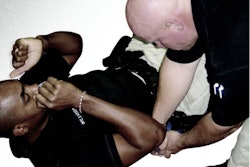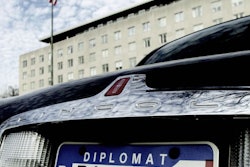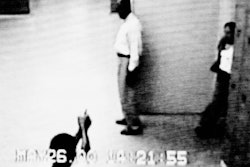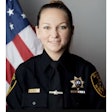In April, as the world watched millions of people descend on Vatican City for the funeral of Pope John Paul II, few would have realized that they were watching the inspiration for the crowd management tactics employed by America’s largest police force.
Several years ago, a high-ranking executive with the New York City Police Department visited St. Peter’s Square. He returned to New York from Italy and talked to his department about the effective way safety lanes were being used to control crowds in Vatican City. After doing its own research, the NYPD decided to try similar procedures and found them to be very effective.
In the NYPD’s modified version of the Vatican City crowd management strategy, crowds are separated into smaller groups using barriers. Then lanes are created that allow public safety personnel to walk through the crowd. Even larger lanes are created so emergency vehicles such as fire engines or ambulances can move into or through the crowd as necessary.
Times Square
The Big Apple’s crowd management strategy is most evident during two major events: the Macy’s Thanksgiving Day Parade and New Year’s Eve in Times Square.
“Initially in Times Square, people would inundate the area without any control on where they would be,” says Allan Howell, former chief of the NYPD’s Manhattan South Division. “Many of them would come intoxicated or would become intoxicated while they were there.”
There was also crime. Groups of pickpockets and worse preyed on the crowd. “The crowds were so dense, the perception was they could get away without a police officer catching them, and they were right,” Howell says, adding that each year would bring hundreds of robberies, assaults, and disorderly conduct incidents.
“It was kind of scary,” Howell admits. “We would say anyone who has been here for New Year’s and comes back for a second time, there had to be something wrong with them, unless they were assigned there as a police officer.” He adds that when those conditions prevailed the members of his department would warn people to stay away.
NYPD officers stopped giving such advice when they started to manage the crowds using wooden and metal barriers and the number of crimes began to diminish.
At first the controlled zones were large, and the problems continued. But by adjusting the configurations of the barriers, New York’s finest learned how to do the job. They eventually decreased the size of the area where crowds could congregate. The zones were reduced to two in a one-block area. When each zone was 75 percent filled, no more people were allowed in. Each zone was surrounded by a “frozen zone,” which allowed police to patrol the perimeters.
An added advantage to the zone system is it allowed police to take alcohol away from revelers once they were in each cordoned off area. This tactic was soon revised so that officers began confiscating alcohol as people entered their zone.
By the time of the massive millennium celebrations in 2000, the crowd was so well managed during New Year’s events in Times Square that NYPD officers invited their spouses. “We reduced the problems in the area to really zero and the last several years no serious crimes have been committed, which is quite amazing.”
Advance Planning
With good planning and coordinated response, crowd control can be successful. Without it, events can spiral out of control, tactics can backfire, and officers can find themselves in trouble.
Within the past few years, Boston has hosted the Democratic National Convention, three NFL championship celebrations, and a Red Sox World Series championship. As a result, the Boston Police Department has learned some hard lessons about crowd management.
Superintendent Robert Donford readily admits his department has had its share of crowd control successes and failures. He says the root of the failures is easily determined. “We didn’t follow our own plans and protocols to handle these groups,” Donford explains.
Unfortunately for Donford and his department, it is the failures that can mark an agency.
Last October after the final game of the World Series, an estimated 60,000 to 80,000 people began celebrating in the area surrounding Fenway Park. Police feared the crowd would get out of control. In an attempt to disperse the crowd, Boston officers deployed a CO2-powered OC launcher. They fired the weapon into the crowd, and a 21-year-old college student was hit in the eye by a projectile filled with OC powder. She later died of a brain injury.
“Some people were injured and a young girl lost her life,” says Donford. “Our own policies were not complied with, and we have very serious consequences because of it.”
Lessons were learned from that incident and others, lessons that have become invaluable to the Boston PD. The city now has a detailed crowd control plan, one that is constantly being updated and critiqued.
Most of the events the Boston PD handles are organized demonstrations, which allows officers to contact a person to negotiate things like what the demonstrators want to do, the number of people they expect, where they will form, where they intend to march to, and how they will disperse. These types of events are the easiest to manage because they can be planned for in detail.
Another type of crowd control scenario that Boston PD has to deal with is the spontaneous celebration of sports championships. This can be the most difficult type of crowd control situation because the people involved have no leadership and no organization.
Boston PD prepares for these events by the formulation of an operational plan. This plan includes an outline of what to expect, a concept of how to deal with what may take place, and it accounts for different scenarios.
“We try to develop strategies so that our commanders know before the incident, if the crowd does this, this is our response,” Donford explains. “Our advance planning is very detailed, including which way to move the crowd if it forms in a certain location,” he says.
Boston PD’s pre-event planning has been refined to where it is now a very meticulous exercise. Using available intelligence, commanders role play and table-top different strategies against a variety of scenarios.
Action and Reaction
Of course, you can only plan for so many crowd control contingencies. Actual events will surprise you.
“The worst thing that sometimes can occur is a new picture, something you may not be prepared for, and then you have to make decisions on the fly,” says Donford. “But if you can sit down with the commanders and think of worst-case situations, the commanders already have a scripted approach such as, if this group does this, this is what we do.”
Donford adds that the key to strategic reaction to the unexpected is to have someone in charge of the entire operation. This “supreme” commander should be positioned in a tactical operations center where he or she has access to intel from all units at the event and can see the big picture.
“One of the things we have found, through experience and trial and error, is that somebody has to be overlooking the entire operation,” Donford explains. “The incident commander on the street has so many things to do, so many distractions, that he or she is not able to monitor the entire picture.”
In order to deal with this problem, Boston police broke commands down into geographical areas or zones. Each zone is the responsibility of an individual commander who is assigned specific resources. In addition, tactical resources are available that can deploy to support any zone that needs assistance. The tactical and the uniformed commands are centralized into one place, which controls the entire city. They can also direct the state police and any other resources that need to be brought in such as fire, EMS, public works, and other public safety agencies.
Another element in the Boston PD’s crowd control strategy is technology. Video cameras are positioned to provide the command center with both real-time visuals and recorded evidence of exactly what happened at the event.
When an event is over, Boston PD compiles after-action reports and reviews of its operations. The reports include discussions of what was learned, what went wrong, and what were the best practices. Participants also share their observations and their recommendations, scrutinizing every aspect of the event to see if anything could have been done better and if more training is needed.
In addition to analyzing its own performance, Boston PD also studies how other agencies handle their crowd control issues. “We have done a great deal of research about what other police departments have experienced, not only in this country but in Europe. We are not original thinkers, we are practical thinkers,” Donford adds.
Bikers and Beaches
Sometimes techniques used for crowd management can be controversial, even if they don’t involve police confrontations with the public.
The Myrtle Beach (S.C.) Police Department is being sued over its efforts to manage crowd and traffic movement during two spring motorcycle rallies. At issue is the fact that one of the rallies primarily attracts African-American bikers and the other attracts primarily white bikers. The NAACP says that the two groups of bikers are treated differently and that police crowd and traffic management strategies employed during “Black Biker Week” are racist. It has filed a legal action against the city. (See “Crowd Control Goes to Court” on page 32.)
Such issues aside, Myrtle Beach is an interesting study in crowd management. The city has a year-round population of less than 25,000 and the motorcycle events draw crowds well over eight times that size. Fortunately, the Myrtle Beach infrastructure is much larger than that of most small cities because it has to cope with massive summer tourism that swells the city’s population by more than 10 times its normal size.
According to Capt. David Knipes, the Myrtle Beach PD starts planning for the May rallies early each year. “We’ve been doing it for a couple of years, but you have to start early,” he explains. “This year we started back in January.”
Aid from other local and state agencies is also critical because, during the rallies, Myrtle Beach needs a much larger force than its normal strength. It also goes without saying that no Myrtle Beach officer should expect time off or even his or her regular days off when the bikers are in town. “With more people in town, more things are going on than usual,” Knipes says. “There are many more calls for service, so we want to have officers available to answer calls in a timely fashion.”
In addition to making a variety of in-house preparations for the dual spring motorcycle rallies, the Myrtle Beach PD has formed what local authorities call a “friendship team,” a group of community and religious leaders that help the agency communicate with the bikers and the local public. The friendship team includes 50 to 100 members.
“The people who serve with the friendship team educate the crowds about local laws or statutes and they answer questions,” says Knipes. “Their only ID is the shirts they wear and basically they go and try to assist us and the crowds to make it a more enjoyable event for everybody.”
Chasing Them Away
Each May motorcycles descend on Myrtle Beach. Much further north, in Harrisburg, Pa., the issue is cars. Lots of ’em.
For several years, a tuner car show took place in Carlisle, Pa. When it started getting too big for such a small town, the organizers moved the event to Harrisburg. There, it boomed, drawing thousands of car enthusiasts and bringing with it numerous problems. Tuner cars are all about youth and speed and the show attracted a crowd that reveled in reckless driving, often under the influence of drugs and/or alcohol.
Harrisburg city officials knew they had to do something to get the mess under control. So the Harrisburg Police Department launched a stringent crowd control plan.
“We looked at what happened in the past, which was pretty much devastating for the smaller townships,” says Charles Kellar, chief of the Harrisburg PD.
The problem was not the event itself but the behavior of the enthusiasts after the show closed. According to Kellar, the drivers would come back in large numbers, drive recklessly, do burnouts, and generally disrupt the city.
Kellar contacted the promoter and set up some preliminary rules. For example, Harrisburg officers searched each vehicle as it entered the event. If they found alcohol, it was turned over to the promoter.
Word quickly got out, and with a large police presence, the show was not a big problem.
Harrisburg officers also had a plan to prevent bad behavior after the show. “We pretty much inundated every place we saw a tuner car with a cop,” explains Kellar. “We made a pre-emptive strike, never let it get out of hand. Every place they looked, they saw us.”
Kellar says it took a great deal of his resources and a 24-hour detail to police the show, but his department was successful in two ways: There were no major problems during the event and, because of the strict controls, the participants don’t want to come back.
“The kids didn’t enjoy it,” says Kellar. “It cost them a whole lot of money. We cited everybody, had zero tolerance, and issued no warnings. That is the only way to maintain it. When going into a proven disaster, you go in, set the tone, and stick to it.”
As with any procedure, crowd control differs from locality to locality. What does not change is that departments need to begin preparations for big events early; maintain good communication with promoters, when possible; formulate detailed plans that are reviewed extensively and repeatedly; and critique every incident for successes and failures.
Finally, law enforcement faced with crowd management and crowd control concerns should share information and learn from each other.
Shelly Feuer Domash is a Long Island-based freelance writer and a frequent contributor to Police magazine.
Crowd Control Goes to Court
South Carolina’s Grand Strand area is a 52-mile stretch of virtually unbroken beaches that encompasses dozens of small towns and communities. The anchor for this region is the city of Myrtle Beach, which boasts a year-round population of about 25,000 and a summer weekend tourist population of more than 10 times that number.
Each year the Grand Strand’s summer tourism season kicks off with two major motorcycle rallies known to the locals as “Biker Weekend” and “Black Biker Weekend.”
Harley-Davidson bikes are the focus of Biker Weekend, held in mid-May, and the event draws a crowd that includes doctors, lawyers, families, and outlaw motorcycle gangs. In general, the Biker Weekend events are held in and around downtown Myrtle Beach.
Black Biker Weekend is the larger of the two events. It occurs over the Memorial Day holiday, and its focus is not on a specific make of motorcycles but just the desire of cyclists to hang together, party, and play with all sorts of bikes. Originally, the majority of the Black Biker Weekend festivities were held in Atlantic Beach, a small, once-segregated community north of Myrtle Beach. Today, the event is so large that it has spread into surrounding communities.
For Black Biker Weekend, the Myrtle Beach PD executes a traffic management plan that it says prevents area gridlock. The NAACP has sued the city in federal court, saying the traffic control plan imposed for Black Biker Weekend is racist because it channels the motorcycle rally traffic into specific lanes and temporarily changes Ocean Boulevard in downtown Myrtle Beach to a one-way street. These measures are not in effect during the primarily white Biker Weekend.
Myrtle Beach officials counter that the reason traffic patterns are different during Black Biker Weekend has more to do with the size of the crowd rather than the color of the participants. They say that Black Biker Weekend draws as many as 350,000 people to the area. In contrast, they estimate the size of the Biker Weekend crowd at about 200,000. They also argue that because Black Biker Weekend occurs on an already busy holiday weekend that the traffic patterns imposed on the motorcyclists are the only way to prevent massive gridlock on area roads.
Police nationwide are watching this case because it could affect crowd management plans in many jurisdictions, not just in Myrtle Beach.












